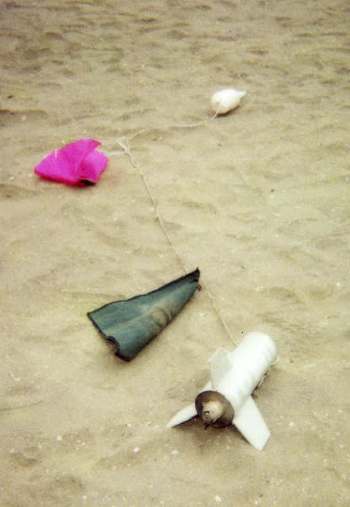Modification Fat Boy to Schnoz Modification
Modification - Fat Boy to Schnoz {Modification}
Contributed by Larry Brand
| Manufacturer: | Modification |
 Brief:
Brief:
The problem with overpowering a "stubby" design like the C-powered Estes Fat Boy with heavier engines is the CG dilemma -- the more power, the more nose weight is needed to keep the CG in limits, negating the Oomph you thought you were adding. I have modified Fat Boy for F-power with a nose cone extension to counter-ballast this with minimal added weight.
Modifications:
The only other modifications I made to create my Schnoz Boy was some modest reinforcing to accommodate the 8-fold increase in thrust (C to F).
The stock fins were trimmed to fit a 24mm motor tube (or a 29 mm works, too) and doubled on one side with 1/64" sheet plywood (a snap, this stuff cuts with a scissors) epoxied on. A 1/8" Lite-Ply-tm doubler was constructed for each of the cardstock motor centering rings supplied with the kit. And that's it. To complete the make-over, I added a "professional" recovery system consisting of an 18" LOC nylon chute and 10 feet of nylon Marine Corps shoe lace (see landing photo), anchored through the body tube with a knot covered with a plastic fairing. Copying a final touch I saw in a magazine, I couldn't resist rearranging the stock Fat Boy decal to spell "YO BATF".
Construction:
A 5" 24mm Estes nose cone was ballasted with 35g of lead fishing sinkers epoxied into the tip. The "supplemental" nose cone is then affixed to the stock Fat Boy cone, using a self-tapping sheet metal screw set into the stock cone and protruding 1/2" to allow a gob of epoxy to anchor the pointy ballast box in place. This puts the CG with a 62g F21 at 6.5" from the tail, well ahead of the Cp (3.9" from the tail). I call the finished product "Schnoz Boy", for the obvious reason. See photo.
This was an easy conversion. All the stock pieces were used, and its a great kit. The through the wall fin design makes this easy to convert to higher power. You do need to add a proper recovery system for E-F-G power, however, and reinforcing the balsa fins for the much higher speeds is essential. I know over the years many folks have had fun overpowering Fat Boys with G80's and H180's and even more thrust -- but seriously, how many of these plywood-finned, fiberglass-reinforced cardboard mortar shells do you ever get back in one piece? Schnoz Boy is a spectacular flier on F-power, and you get it back to fly again and again. It makes for an interesting drag race when you sneak it alongside some kid's C6-7 Fat Boy on the club launch rack.
 Flight:
Flight:
How does Schnoz Boy fly? On E30-7's, it roars up to about 800-900' in the blink of an eye. On an F21-8, it rides a foot long sheet of flame to at least 1700', with ejection about at apogee (not that you can really see this). I have several F24 reloads I plan to try in it. A good first flight was had on a D12-5, but Schnoz Boy is too heavy to fly well on an Estes E9-6 (meaning that I tried, and I don't want to talk about it). After 11 flights to date, not a bit of damage (except to the stock 18" Estes plastic chute, which shredded on the first E30 flight, dropping Schnoz Boy onto a sand dune). The only shortcoming with Schnoz Boy lies in the future of Aerotech as sole supplier of single-use 24mm/29mm E-F-G motors, without which it wouldn't be much fun.
Summary:
PRO: This is the way to fly an Estes Fat Boy for "Big Kids"!
CON: Well, of course, you lose the ability to fly on C6-7's, and unless the flow of AP motors in 24mm size restarts, this conversion is too much trouble for just a D12-5 upgrade.
Other:
This approach to changing the rules for ballasting -- moving the nose weight ahead of the stock nose cone instead of inside it -- has a lot of possibilities for balancing rockets of all sizes with minimal added weight.
#Related Reviews
- 2 Fat By Geof Givens
Brief: After a spell of creative scratch rocket projects, all my fun ideas seemed to have dried up. Looking around the workshop, I smiled at good old Fat Boy: both my kids and my favorite rocket. He's always good for an exciting flight and safe recovery. Why not court disaster by trying to improve ...
- Excelsior Rocketry Der Fat Max By Bill Eichelberger
I always loved the versatility of the Estes Fat Boy, and over the years I bought quite a few of them for different projects, most of them of the Goony persuasion. When a fellow club member decide to move away from low power and offered one for sale from his stash, I jumped at the ...
- Fat Boy to AttaBoy Modification By Tad Scheeler
The ATTABOY is a boattailed FATBOY with 24mm upsized motor mount that can be flown in two different configurations--both with and without upper payload tube. Modifications: I was inspired by Michael Bade's " Big Bad V-2 Daddy ", Kevin Johnson's " OY!FATBOY ", and David Fergus' " Boattail FATBOY ...
- Modification 24mm Fat Boy By Morgan Hendry
This project began when I read several posts from rec.model.rockets on placing a 24mm motor mount in a Fat Boy, normally a 18mm kit. I first looked at the instructions and made a list of what I needed to do. Replace the 18mm motor tube with a 24mm one Make bigger motor mount with modified ...
- Modification Fat Boy - 24mm By Morgan Hendry
This project begun when I read several posts from rec.model.rockets on placing a 24mm motor mount in a Fat Boy, normally a 18mm kit. I first looked at the instructions and made a list of what I needed to do. Replace the 18mm motor tube with a 24mm one Make bigger motor mount with modified ...
- Modification Fat Boy - 24mm By Colin Westgarth-Taylor
An Estes Fat Boy modified with a 24mm MMT for D and E motors. External dimensions are stock. These modifications change one of Estes best packaged kits into a true performer. Modifications: Construction sequence was pretty normal for a MPR capable rocket: forward CR epoxied to the MMT, shock ...
- Modification Fat Boy - 29mm By Scott McLeod
An Estes FatBoy modified with a glassed body tube, 29mm MMT and G10 fins for F, G, and H motors. External dimensions are stock. Best "bang-for-buck" rocket that I ever built. Modifications: When glassing the tube, I used a long section of PML 2.6" coupler tube wrapped in greaseproof ...
- Modification Super Baby Bertha By Kevin Johnson
Took a Fat Boy kit and added Big Bertha like fins to make a Super Baby Bertha. Modifications: NARHAMS held a Fat Boy theme sport launch this month, and I was looking for something different to do with my last Fat Boy kit. I had just finished repairing my Super Big Bertha when inspiration ...
- Modification Two-Stage Fat Boy By Kevin Johnson
Kit bashed two Fat Boys into one two-stage rocket. Modifications: After building the sustainer per the instructions, I started the booster by building the motor mount/center rings. Using the completed mount as a guide, I marked the aft end of the second BT and cut it down just in front of ...
- Scratch BoatTail Fat Boy By David Fergus
Brief: Modified BoatTail FatBoy with a D engine mount, sturdier construction throughout, and better fly-ability with a boat tail. The basic dimensions of a stock Fat Boy were maintained for both body length and fin shape and size. Modifications: Body Tube: Cut the main body tube 5 1/8 inch ...
- Scratch Fat Boy (7 x 18mm Motor Eater) By Dick Stafford
This Fat Boy flies on seven 18mm motors. Modifications: Here is what I changed: The base of the cone was cut off The stock centering rings were not used Additional 18mm motor tubes were added Parts list: Estes Fat Boy kit 18mm tubing for the 6 additional motor ...
- Scratch Fat-Ass-Tron Sprint By Jim Sekol
Fat-Ass-Tron Sprint The Fat-Ass-Tron Sprint: The F-A-T Sprint is a combination of the Estes Fat Boy, and the Astron Sprint. It was originally created to address one of the Fat Boy's inherent design flaws, that being ...
Related Products
 |
 |